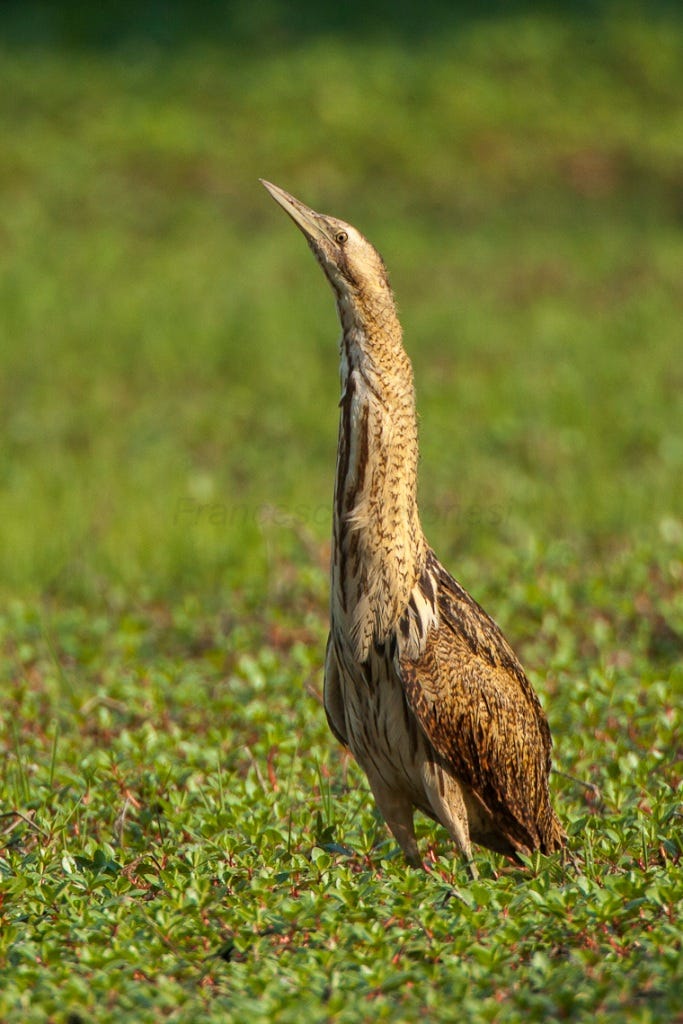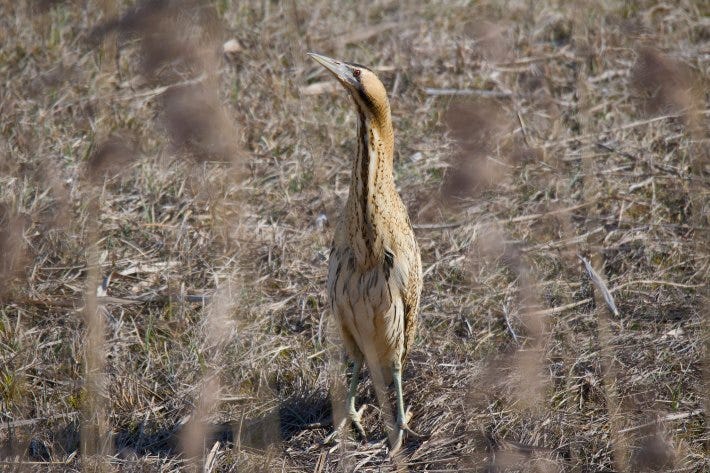
OK, get ready everyone, because this week's Bird of the Week....I just can't say enough good things about the great bittern (also known as the Eurasian bittern, but I'm going with great because this bird???? It's great—and it's also the largest of the bittern species, so double great.)
Everything about the bittern is cool. First, a picture.

What I love about the great bittern is that it is at once totally weird-looking and lovely. It's assembled from all these oddball parts but combines them to form an unexpectedly regal whole. Here are some more views:


This last picture shows the bittern smack dab in the middle of its favorite location: a buncha reeds and water. Bitterns love reeds! They love nesting in them, they love hanging out in them, and they especially love being very cloak-and-dagger in them, because the bittern is a master of going undercover. Read anything about the bittern and words like "stealthy," "secretive," and "elusive" pop up, which is good for the bittern, because it uses that stealth to support its diet of fish, frogs, insects, worms, and the like. As the site Animal Diversity Web recounts:
The Eurasian bittern is a master of stealth and camouflage. Its plumage of streaked brown, grey, and black allow the bittern to blend in with its surroundings. When startled the bittern extends its neck and body such that the streaks on its body parallel the surrounding vegetation, the bittern can even sway parts of its body to cast the illusion of reeds blowing in the wind. A skilled fisher, the bittern often approaches a fishing spot disguising its presence by leading with its camouflaged neck until an opportune time to spear/catch a prey item arises.
A lot of the comments on the pictures I found of bitterns are people saying things like "OMG you saw a bittern!" It ain't easy. The bittern is very into hanging back in the midst of a huge clump of reeds.


The fish are no match!
Here's a long video of the bittern just doing its thing: wading, hiding, chilling. Very zen, I love its walk. The last 20 seconds are hilarious because they show this huge other bird in the foreground and then the bittern skulking in the reeds in the background. The bird knows itself!
OK, now it is time to get to the really fun stuff, the reasons why the bittern has risen so high in my estimation. First, this, from Wikipedia:
Its folk names, often local, include many variations on the themes of "barrel-maker", "bog-bull", "bog hen", "bog-trotter", "bog-bumper", "mire drum[ble]", "butter bump", "bitter bum",[12] "bog blutter", "bog drum", "boom bird", "bottle-bump", "bull of the bog", "bull of the mire", "bumpy cors", and "heather blutter".[13]
laksjdfhaslkjdhfalskjhdfasdf what!!!! "Bog blutter"?!? "Mire drumble"??? "Bitter bum"??? Yes!!!
Then there is the sound the great bittern makes. When I say oh my god, I mean....get READY.
Sound on people. They don't call it the boom of the bittern for nothing.
I cannot get enough of this!!!!! Not only the sound itself, but the little warm-up clacks the bittern makes, before going into that tuba-foghorn-wow sound that literally takes its whole body to produce. And then it raises itself up again and kinda preens??? Incredible. A look at multiple videos shows that this routine is not a one-off. These birds are doing this exact thing all the time!
The bittern's boom is legendary. It was referenced in Arthur Conan Doyle's The Hound of the Baskervilles (emphasis mine):
Stapleton looked at me with a curious expression in his face.
“Queer place, the moor!” said he.
“But what is it?”
“The peasants say it is the Hound of the Baskervilles calling for its prey. I’ve heard it once or twice before, but never quite so loud.”
I looked round, with a chill of fear in my heart, at the huge swelling plain, mottled with the green patches of rushes. Nothing stirred over the vast expanse save a pair of ravens, which croaked loudly from a tor behind us.
“You are an educated man. You don’t believe such nonsense as that?” said I. “What do you think is the cause of so strange a sound?”
“Bogs make queer noises sometimes. It’s the mud settling, or the water rising, or something.”
“No, no, that was a living voice.”
“Well, perhaps it was. Did you ever hear a bittern booming?”
“No, I never did.”
“It’s a very rare bird—practically extinct—in England now, but all things are possible upon the moor. Yes, I should not be surprised to learn that what we have heard is the cry of the last of the bitterns.”
“It’s the weirdest, strangest thing that ever I heard in my life.”
Spoiler alert: it wasn't the cry of the bittern. (The bird also showed up in The Canterbury Tales and quite a few other pieces of literature and poetry.)
The "practically extinct" part is true—the bittern used to be in England, then vanished completely in the late 19th century, then came back in the 20th century, then was facing extinction in the UK again, and is now making another recovery, though there are still just a couple hundred of them in the country. (The bittern isn't doing too badly overall, though—it can be found all over Europe and Asia and in many parts of Africa too.)
Guess how researchers determine how many bitterns are out there so they can get an accurate tally of the bird's numbers in a given area? That's right: they follow the sound of its boom.
That's not all. The bittern's boom was used to RECREATE THE SOUND OF A T REX. From the Telegraph:
For a new BBC documentary, naturalist Chris Packham visited Julia Clarke, professor of Vertebrate Palaeontology at the University of Texas, to test out the theory that dinosaurs actually sounded more like birds and reptiles, than today’s predatory mammals.
“The most chilling noises in the natural world today come from predators, the howl of the wolf, the roar of the tiger, but experts now doubt that T-Rex sounded anything like them,” said Packham.
Dinosaurs are the ancestors of birds and are closely related to alligators and crocodiles, so Prof Clarke used the sound of the Eurasian bittern, which makes an unearthly booming call, and the vocalisations of Chinese crocodiles to estimate the noise T-Rex would have made.
This is what that sounded like. That's the bittern!
OK one last thing: this video is a little low-quality but it shows the bittern reacting to a threat and it is a sight to see:
I have to stop myself from going on and on and on, so I have to end things here. What. A. Bird.
A reminder: you can check out our complete Bird of the Week list here, and get in touch with your bird suggestions at hello@discourseblog.com.











